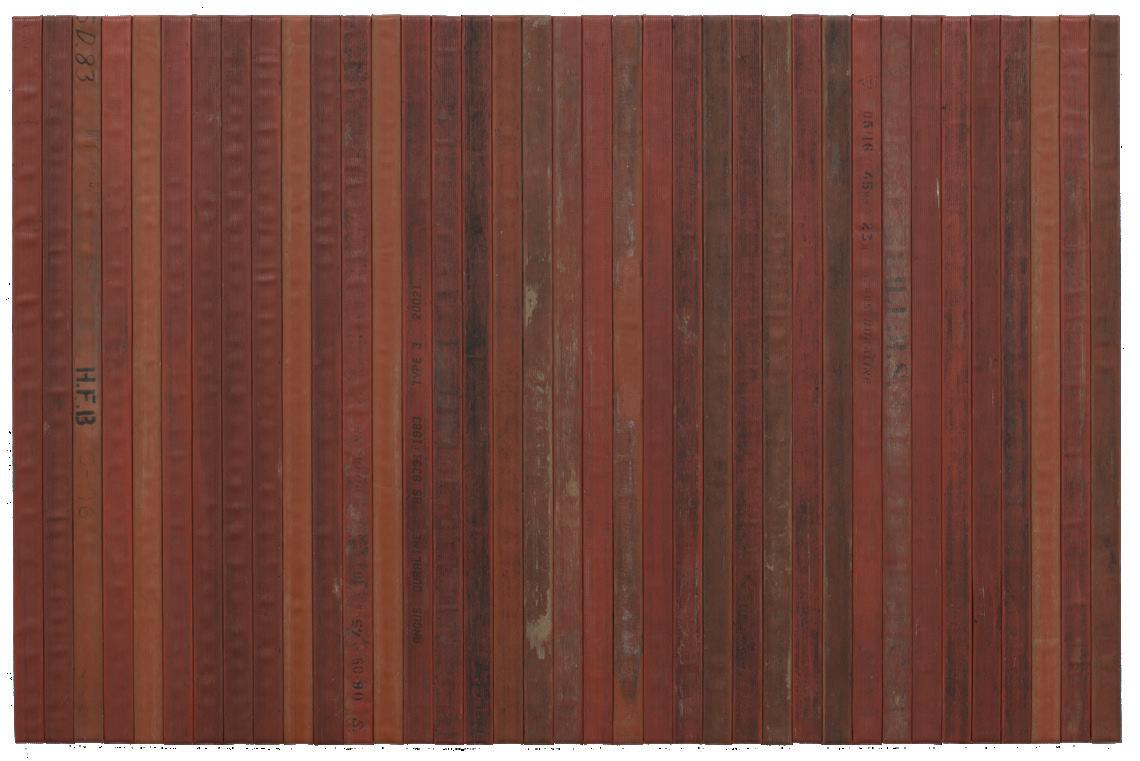
5 minute read
A VISUAL HISTORY LESSON IN COLOR
Japan-based curator Dexter Wimberly brings Black Abstractionists: From Then ‘til Now to life.
BY DARRYL RATCLIFF
There is a sense of wonder when one realizes something that is obviously true but was previously out of reach as a form of personal revelation. For me the hit Jay-Z and Kanye West song N***s in in Paris was one of those moments. Because of course there are Black people in Paris, as there are Black people everywhere. But the charm of the song, at least for me as a young Black American, was that I too could potentially be a Black person in Paris, as opposed to a Black person in Dallas, Texas; or America; or anywhere else.
In a similarly obvious way, it should come as no surprise that Black artists make abstract art. Because of course, if there are Black people making visual art, there are Black people making abstract art, as well as any other style of art one can think of. But for some viewers, the charm of Black Abstractionists: From Then ‘til Now will be that it will help one conceive of Black art outside of the realm of realism and figuration.
The exhibition is curated by Dexter Wimberly, a Black American curator based in Japan, and serves as the inaugural show of the new Green Family Art Foundation exhibition space in the Dallas Arts District. Wimberly is well aware that the dynamic between Black abstraction and Black figuration is not a new one. In fact, part of what makes Black Abstractionists so compelling is that it offers a rare visual history lesson of the progression of Black abstraction from the 1950s to the present.


Alma Thomas, Alma’s Flower Garden, 1968-70, acrylic on canvas, 34.25 x 50 in. Courtesy Ortuzar Projects, New York. Photography by Timothy Doyon; Virginia Jaramillo, Untitled, 1969, acrylic on canvas 72 x 72 in. ©Virginia Jaramillo. Photography by JSP Art Photography; Charles Alston, Untitled (Cityscape at Night), c. 1950-55, oil on canvas, 20 x 24.32 in. ©Estate of Charles Alston. Courtesy The Johnson Collection, Spartanburg, South Carolina. Photography by The Johnson Collection, Spartanburg, SC.






Clockwise from top left: Theaster Gates, A Study in Red 1, 2021, wood and decommissioned fire hose 71.93 x 109.75 x 4.75 in.; Kevin Beasley, Untitled (Halo Rags), 2019, polyurethane resin, raw Virginia cotton, Virginia soil, Virginia twigs, Virginia pinecones and needles, housedresses, kaftans, du-rags, altered garments, 78 x 60.5 x 5.5 in. ©Kevin Beasley. Courtesy of the artist and Casey Kaplan Gallery, New York; Photograph by Kevin Todora; Mark Bradford, Q2, 2020, mixed media on canvas 72 x 96 in. ©Mark Bradford; Norman Lewis, Aspiration, 1966, oil on canvas, 37.5 x 60.125 in. ©Estate of Norman Lewis; Courtesy of Michael Rosenfeld Gallery LLC, New York, NY; Fred Eversley, Untitled (parabolic lens), 1978, cast polyester, 19.5 x 19.5 x 2.5 in. Courtesy of David Kordansky Gallery, Los Angeles; Leonardo Drew, Number 212T, 2021, wood and paint, 68 x 84 x 34 in. ©Leonardo Drew. Courtesy of Talley Dunn Gallery and the artist.






Clockwise from top left: Jack Whitten, Untitled I, 1974-75, acrylic on canvas, 41.75 x 41.75 in. ©Estate of Jack Whitten; Stanley Whitney, Untitled, 2006, oil on linen, 12.13 x 12.12 in.; Howardena Pindell, Untitled #42, 1974, thread, acrylic, watercolor, punched paper, and gouache on mat board, 8 x 7.38 in. Asheville Art Museum, gift of Ladene and Russell Newton in honor of Rebecca Lynch. ©Howardena Pindell. Courtesy the artist and Garth Greenan Gallery, New York. Image David Dietrich, courtesy Asheville Art Museum; Sam Gilliam, Untitled, 1968, acrylic on canvas, 62 x 66.5 x 3.5 in. ©Sam Gilliam/Artist's Rights Society (ARS), New York. Courtesy of David Kordansky Gallery, Los Angeles. Photograph by Jeff McLane; Rick Lowe, Fire #3, 2021, acrylic and paper collage on canvas, 48 x 36 in. ©Rick Lowe Studio. Courtesy of artist and Gagosian; Jadé Fadojutimi, My Pathetic Fallacy, 2019, oil on canvas, 70.8 x 86.6 in. ©Jadé Fadojutimi. Courtesy Galerie Gisela Capitain, Cologne.
David Hammons, Untitled (coat), 2007, mixed media and American mink fur, 72.5 x 15.5 x 10 in. ©David Hammons. Photography ©White Cube.
This show is in some ways the inverse of the 2021 Green Family Art Foundation exhibition Black Bodies, White Spaces: Invisibility and Hypervisibility curated by Aindrea Emelife. That show focused on Black figurative forms and seemed very much a commentary on the popularity of Black art in the contemporary art world at the time. This exhibition feels more like an investigation of the canon than a highlight reel of Black abstract painters of today.
Scanning through the images of the show felt like viewing an alternative version of art history. If you like Helen Frankenthaler, can I interest you in Alma Thomas? Georges Braque? Meet Charles Alston. Did you know that Beauford Delaney also found refuge in France, alongside James Baldwin? The history and the rhymes come effortlessly.
And so too does the defiance—the unapologetic Blackness of the work. In case one didn’t know, the prerequisite for Black art is that it be made by a Black artist. The exhibition is full of some of the most important living Black artists, such as Glenn Ligon, Rick Lowe, Theaster Gates, Mark Bradford, Melvin Edwards, and Leonardo Drew.
The Green Family Art Foundation was founded by art collectors Debbie and Eric Green alongside their son Adam Green, who runs an art advisory service. Bailey Summers is the current director of the foundation. The move to Flora Street doubles the exhibition space they were operating out of in the Design District, and it adds more accessibility for both local Dallasites and out-of-town visitors alike.
Black Abstractionists shows that the foundation intends to assemble big, museum-quality shows that could be at the neighboring Dallas Museum of Art and Nasher Sculpture Center. If this continues, it will be a worthy addition to the Dallas Arts District, filling an important gap with its focus on BIPOC, queer, and women artists. P










